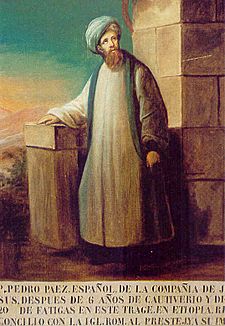Pedro Páez facts for kids
Quick facts for kids Pedro Páez y Jaramillo |
|
 Undated portrait of Páez |
|
| Born | 1564 in Olmeda de la Cebolla, Comarca de Alcalá, Spain |
|---|---|
| Died | May 22, 1622 (aged 57) in Gorgora, Ethiopia |
| Church | Catholic Church |
| Other names | Pêro Pais (Portuguese) |
| Education | University of Alcalá |
| Ordained | c. 1588 |
Pedro Páez y Jaramillo (born 1564, died May 22, 1622) was a Spanish Jesuit missionary. He worked in Ethiopia and is seen as a very successful Catholic missionary there.
Many believe he was the first European to discover and describe the source of the Blue Nile river. He reached this important spot on April 21, 1618.
Páez also wrote a two-volume book called História da Ethiópia (History of Ethiopia). Experts on Ethiopian history consider his book to be one of the most valuable and accurate works about the Solomonic Empire of his time. It is especially important because many writings from local historians were lost over the centuries.
Contents
His Life and Adventures
Early Years and Education
Pedro Páez was born in 1564 in a village called Olmeda de la Cebolla. This village is now known as Olmeda de las Fuentes, near Madrid, Spain.
When he was young, he studied at a Jesuit college in Belmonte, Spain. Later, he continued his higher studies at the University of Alcalá. Around this time, he joined the Society of Jesus, a Catholic religious order. He later became a priest.
Journey to the East
As a Jesuit, Páez wanted to serve in the East Indies, which included places like India. In 1588, he was sent to Goa, a city in Portuguese India. There, he worked at the College of St. Paul, run by the Jesuits.
The next year, King Philip II of Spain ordered some Jesuits to go to Ethiopia. Their job was to find other Jesuits who were already there. They also needed to explore if the Ethiopian Orthodox Tewahedo Church could unite with the Catholic Church.
Captured and Held Hostage
Páez and another Jesuit, Abraham de Monserrat, set out for Ethiopia. But when they arrived in Yemen, they were betrayed. The local officer who was supposed to help them handed them over to local leaders.
Páez and Monserrat were held captive for almost seven years, from 1590 to 1596. During this difficult time, Páez learned to speak Arabic. He also traveled through the Hadramaut and Rub' al Khali deserts. He even tasted coffee in Mocha, probably being the first European to do so!
Finally, other Jesuits in Goa paid a ransom for their release. Páez and Monserrat returned to Goa to recover. Sadly, Monserrat never fully recovered and died in 1600.
Arrival in Ethiopia
After he recovered, Páez set out for Ethiopia again. He finally arrived in Massawa in 1603. From there, he traveled to Debarwa and then to Fremona, which was the main Jesuit base in Ethiopia.
Unlike some earlier missionaries, Páez was known for being gentle and understanding. He was also very learned.
Meeting the Emperors
Páez was called to the court of the young Ethiopian Emperor, Za Dengel. Páez impressed the Emperor with his knowledge of Amharic and Ge'ez, which are Ethiopian languages. He also understood Ethiopian customs very well.
Emperor Za Dengel was so impressed that he decided to become Catholic. However, Páez wisely warned him not to announce this too quickly. When Za Dengel did declare changes, it led to a civil war. Páez stayed out of the conflict and waited for it to end.
This careful approach helped Páez when Susenyos I became Emperor in 1607. Susenyos invited Páez to his court, and they became good friends. Emperor Susenyos gave Páez land on the Gorgora peninsula, near Lake Tana. There, Páez built a new center for the Jesuits, including a stone church. This church was opened on January 16, 1621.
Eventually, Páez also convinced Emperor Susenyos to convert to Catholicism. This happened shortly before Páez died in 1622. Some of the Catholic churches Páez designed are still standing today. They influenced Ethiopian architecture for many years.
Unfortunately, Páez's hard work did not last long. Other Jesuits who came after him used stricter methods. This led to their expulsion from Ethiopia in 1633.
His Writings
Páez finished his book about Ethiopia, História da Ethiópia, in 1620. However, it was not published while he was alive. Another Jesuit, Manuel de Almeida, used much of Páez's work for his own book years later.
After almost 300 years, Páez's history was finally printed. It was published in a collection of Western writings about Ethiopia. A new edition of his book was also published in 1945.
Besides his famous history book, Páez also translated the Roman Catechism into Ge'ez. He is also thought to have written a paper called De Abyssinorum erroribus, which means "About the Errors of the Abyssinians." His História da Ethiópia was translated into English in 2011.
See also
 In Spanish: Pedro Páez para niños
In Spanish: Pedro Páez para niños

